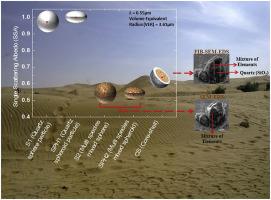当前位置:
X-MOL 学术
›
Atmos. Environ.
›
论文详情
Our official English website, www.x-mol.net, welcomes your
feedback! (Note: you will need to create a separate account there.)
Three-dimensional physico-chemical characterization of coarse atmospheric particles from urban and arid environment of India: An insight into particle optics
Atmospheric Environment ( IF 4.2 ) Pub Date : 2020-07-01 , DOI: 10.1016/j.atmosenv.2020.117338 Vikas Goel , Sumit K. Mishra , Ajit Ahlawat , Prashant Kumar , T.D. Senguttuvan , Chhemendra Sharma , Jeffrey S. Reid
Atmospheric Environment ( IF 4.2 ) Pub Date : 2020-07-01 , DOI: 10.1016/j.atmosenv.2020.117338 Vikas Goel , Sumit K. Mishra , Ajit Ahlawat , Prashant Kumar , T.D. Senguttuvan , Chhemendra Sharma , Jeffrey S. Reid

|
Aerosol particles scatter and absorb solar radiation and affect the Earth's radiation budget. The aerosol particles are usually non-spherical in shape and inhomogeneous in chemical composition. For simplicity, these particles are approximated as homogeneous spheres/spheroids in radiative models and in retrieval algorithms of the ground and spaceborne observations. The lack of information on particle morphology (especially shape), chemical composition (that govern their spectral refractive indices) and most importantly internal structure (three dimensional spatial distribution of chemical species) lead to uncertainty in the numerical estimation of their optical and radiative properties. Here, we present a comprehensive assessment of the particles' volumetric composition. The particles were collected from Jaisalmer (arid environment) and Delhi (urban environment) of India and subjected to Focused Ion-Beam (FIB) coupled with Scanning Electron Microscopy (SEM) and Energy Dispersive X-ray Spectroscope (EDS). Based on analysis of #2 particles from Jaisalmer, particles were observed to be composed of Fe, Ca, C, Al, Cu and Mg rich shell with Si and O rich core as opposed to those of Delhi particles (no #3) which were observed to be with Cu and S rich core and Hg, Ag, C, S and N rich shell. Based on the homogeneous sphere/spheroid assumption, conventional SEM-EDS and FIB-SEM-EDS results, different particle model shapes [single species homogeneous sphere (SP1) and spheroid (SPH1); multiple species homogeneously mixed sphere (SP2) and spheroid (SPH2); and core-shell (CS)] were considered for simulating their respective optical properties; SSA (Single Scattering Albedo) and g (Asymmetry parameter). The effect of internal structure on SSA was found to be prominent in particles having low value of the imaginary part of refractive index (k). While the same was observed to be low (nearly negligible) for the particle with the high value of k. The particles rich in copper are found to have high light absorbing property which causes positive radiative forcing.
中文翻译:

来自印度城市和干旱环境的大气粗颗粒的三维物理化学表征:对粒子光学的洞察
气溶胶粒子散射和吸收太阳辐射并影响地球的辐射收支。气溶胶颗粒通常呈非球形且化学成分不均匀。为简单起见,在辐射模型以及地面和星载观测的检索算法中,这些粒子被近似为均质球体/椭球体。缺乏关于粒子形态(尤其是形状)、化学成分(控制它们的光谱折射率)和最重要的内部结构(化学物质的三维空间分布)的信息导致对其光学和辐射特性的数值估计的不确定性。在这里,我们对颗粒的体积组成进行了全面评估。这些颗粒是从印度的斋沙默尔(干旱环境)和德里(城市环境)收集的,并进行聚焦离子束(FIB)、扫描电子显微镜(SEM)和能量色散 X 射线光谱仪(EDS)。根据对来自 Jaisalmer 的 #2 颗粒的分析,观察到颗粒由富含 Fe、Ca、C、Al、Cu 和 Mg 的壳组成,具有富含 Si 和 O 的核,而德里颗粒(没有 #3)则是观察到富含Cu和S的核和富含Hg、Ag、C、S和N的壳。基于均质球体/类球体假设,常规SEM-EDS和FIB-SEM-EDS结果,不同粒子模型形状[单一物种均质球体(SP1)和类球体(SPH1);多物种均匀混合球体(SP2)和球体(SPH2);和核壳(CS)]被考虑用于模拟它们各自的光学特性;SSA(单散射反照率)和 g(不对称参数)。发现内部结构对 SSA 的影响在具有低折射率虚部值 (k) 的颗粒中尤为突出。而对于具有高 k 值的粒子,观察到相同的值很低(几乎可以忽略不计)。发现富含铜的颗粒具有导致正辐射强迫的高光吸收特性。
更新日期:2020-07-01
中文翻译:

来自印度城市和干旱环境的大气粗颗粒的三维物理化学表征:对粒子光学的洞察
气溶胶粒子散射和吸收太阳辐射并影响地球的辐射收支。气溶胶颗粒通常呈非球形且化学成分不均匀。为简单起见,在辐射模型以及地面和星载观测的检索算法中,这些粒子被近似为均质球体/椭球体。缺乏关于粒子形态(尤其是形状)、化学成分(控制它们的光谱折射率)和最重要的内部结构(化学物质的三维空间分布)的信息导致对其光学和辐射特性的数值估计的不确定性。在这里,我们对颗粒的体积组成进行了全面评估。这些颗粒是从印度的斋沙默尔(干旱环境)和德里(城市环境)收集的,并进行聚焦离子束(FIB)、扫描电子显微镜(SEM)和能量色散 X 射线光谱仪(EDS)。根据对来自 Jaisalmer 的 #2 颗粒的分析,观察到颗粒由富含 Fe、Ca、C、Al、Cu 和 Mg 的壳组成,具有富含 Si 和 O 的核,而德里颗粒(没有 #3)则是观察到富含Cu和S的核和富含Hg、Ag、C、S和N的壳。基于均质球体/类球体假设,常规SEM-EDS和FIB-SEM-EDS结果,不同粒子模型形状[单一物种均质球体(SP1)和类球体(SPH1);多物种均匀混合球体(SP2)和球体(SPH2);和核壳(CS)]被考虑用于模拟它们各自的光学特性;SSA(单散射反照率)和 g(不对称参数)。发现内部结构对 SSA 的影响在具有低折射率虚部值 (k) 的颗粒中尤为突出。而对于具有高 k 值的粒子,观察到相同的值很低(几乎可以忽略不计)。发现富含铜的颗粒具有导致正辐射强迫的高光吸收特性。











































 京公网安备 11010802027423号
京公网安备 11010802027423号